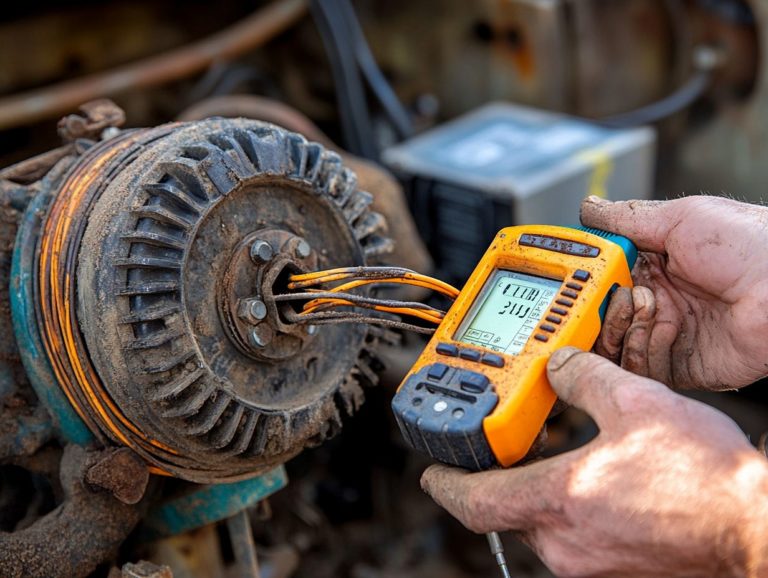How to Change Your Oil: Step-by-Step
Changing your oil is not just a chore; it s a crucial aspect of vehicle maintenance that can significantly extend the life of your engine and boost its performance.
This guide will provide you with a comprehensive list of essential supplies and tools required for the task, followed by a meticulous, step-by-step process for changing your oil from draining the old oil to adding the new.
You will also find helpful tips to help you sidestep common mistakes and understand how often you should undertake this essential maintenance task.
Contents
Key Takeaways:

- Regularly change your oil to maintain your vehicle’s performance and longevity.
- Gather all necessary supplies and tools, including oil, filter, wrench, and drain pan before starting.
- Follow a step-by-step process: drain old oil, replace the filter, and add new oil. Refer to your vehicle’s manual for specific instructions.
Why Changing Your Oil is Important
Changing your oil is crucial for maintaining your vehicle’s peak performance and longevity. It helps your engine run smoothly by providing lubrication. This reduces friction and prevents contamination. Regular oil changes keep oil levels consistent and reduce the risk of leaks, all of which bolster your vehicle’s safety and efficiency.
By following your owner s manual regarding oil change frequency and specifications, you can significantly enhance your engine’s health and performance.
Using the correct oil thickness is vital; it directly influences how well the oil flows through your engine, especially during temperature swings. Opting for high-quality oil that meets or exceeds industry standards can dramatically extend your engine’s life by safeguarding vital components from wear and tear.
Make sure to check your oil pressure regularly. It’s crucial for your engine’s health! These checks can reveal potential issues before they escalate, enabling certified ASE mechanics to tackle problems early on. Ultimately, these practices not only preserve your vehicle s performance but also enhance fuel efficiency, ensuring that your driving experience is both smooth and economical.
Supplies and Tools You Will Need
To successfully change your oil and maintain your vehicle, you ll want to equip yourself with a selection of essential supplies and tools that make the process efficient and effective.
Key items include:
- Use an oil filter wrench for effortless removal of the oil filter.
- Use a reliable car jack to safely lift your vehicle.
- Have an oil drain pan to collect the used oil.
- Keep an oil catch pan to handle any spills.
Having these automotive tools readily available not only streamlines the oil change procedure but also encourages responsible practices for oil disposal. Remember to dispose of your used oil responsibly; it s good for the environment!
Essential Items for the Job
When you’re gearing up for an oil change, it’s essential to gather the right tools to make the process smooth and efficient. Key supplies include the appropriate engine oil, which varies based on specific oil specifications, a compatible oil filter tailored to your vehicle’s needs, and an oil drain plug to prevent any pesky leaks. Don’t forget an oil cap to seal the engine after adding the new oil, along with a proper container for responsibly disposing of the used oil.
Choosing the right engine oil requires an understanding of viscosity ratings. These ratings, like 5W-30 or 10W-40, indicate how thick the oil is and how it performs across different temperatures. The quality of your oil filter can significantly impact engine health, so selecting one that meets original equipment manufacturer requirements is crucial.
During the oil change, using an oil drain pan will help you efficiently capture the old oil for easy disposal. A funnel is a handy addition, ensuring you add the new oil without any spills, thus keeping your workspace tidy. Ultimately, each of these components plays a vital role in ensuring the oil change process is effective, contributing to the longevity of your engine.
Step-by-Step Guide to Changing Your Oil

Changing your oil is a quick and crucial task that can save you money and keep your car running smoothly! It s essential to master this process in just a few easy steps, elevating your car maintenance routine while ensuring your vehicle operates at its best.
By following these oil change instructions, you ll confidently navigate the process, from draining the old oil to replacing the oil filter and adding fresh oil. Committing to this routine not only prolongs the life of your engine but also enhances overall vehicle performance. This results in a more enjoyable driving experience.
Draining the Old Oil
The first step in your oil change journey is draining the old oil from your vehicle. This crucial task prevents contamination and ensures the new oil can work effectively. Start by lifting your vehicle with a car jack and positioning an oil drain pan beneath the oil drain plug.
Let the old oil flow freely into the pan no spills allowed. Remember, disposing of used oil properly according to local regulations is essential to minimize environmental impact.
Before loosening the drain plug, make sure the engine is warm but not too hot; this helps the old oil flow out more smoothly. Grab a socket wrench (typically 3/8″ or 1/2″) and carefully unscrew the drain plug, being mindful not to over-tighten it when you replace it later this rookie mistake can lead to damage.
While the old oil drains, keep an eye out for any leaks; spotting them early can indicate more serious issues that deserve your attention. Position your oil catch pan correctly to avoid messy spills. Proper preparation not only makes the process efficient but also ensures it s a safe endeavor.
Replacing the Oil Filter
Replacing the oil filter is an essential step in the oil change process. It plays a vital role in extending the life of your engine. This task boosts engine performance and safeguards against contaminants that can cause wear and tear over time.
Use an oil filter wrench to carefully remove the old filter. It s crucial to let any residual oil fully drain into the oil drain pan to prevent spills. Make sure the rubber gasket from the old filter has come off with it; a stuck gasket can lead to serious oil leaks.
When you choose a new filter, double-check that it matches your vehicle s specifications to ensure optimal engine functionality. After lubricating the rubber gasket on the new filter, tighten it by hand, then check the oil level to wrap up your maintenance task effectively.
Adding New Oil
Once you’ve drained the old oil and replaced the oil filter, the next vital step is adding new oil essential for maintaining optimal engine performance and oil pressure. Locate the oil cap on your engine and remove it, then pour in the appropriate amount of new oil according to your vehicle’s oil capacity, which you can find in the owner s manual.
Choosing the correct thickness of the oil is crucial to ensure proper lubrication and overall engine health. After you’ve added the new oil, take a moment to let it settle before checking the oil level with the dipstick.
Make sure the oil level is right this simple check can save your engine from serious damage later on! Keep a close watch on the oil pressure gauge during this process; a drop in oil pressure might signal an issue that needs your immediate attention.
Don t forget to revisit the owner s manual for specific recommendations on oil change intervals and viscosity ratings this information meets the unique needs of your vehicle.
Tips for a Successful Oil Change

Achieving a successful oil change goes beyond merely following the steps; it involves embracing best practices that elevate your vehicle care routine to a new level.
Essential tips for an effective oil change include:
- Selecting high-quality engine oil and filters
- Regularly monitoring oil pressure
- Ensuring the responsible disposal of used oil to protect the environment
Engaging with a trusted mechanic can also offer invaluable insights into maintaining the health of your vehicle s engine. This can help you make informed decisions that enhance its longevity and performance.
Remember, taking care of your oil means taking care of your ride!
Common Mistakes to Avoid
When you’re changing your oil, avoiding common mistakes can save you time and prevent expensive repairs. This ensures your vehicle operates smoothly for years to come. Here are frequent pitfalls to watch out for:
- Neglecting to replace the oil filter during the change.
- Over-tightening the drain plug.
- Improperly disposing of used oil.
Failing to monitor for oil leaks after the change can lead to serious engine issues that are easily preventable.
Remember, oil changes are about more than just topping up fluids; they involve a comprehensive inspection of your entire engine system. Many people overlook the importance of using the correct oil type, which can significantly impact performance and longevity. A clean work area is also vital. Dust and debris can contaminate the oil.
Always consult your owner s manual for specific requirements when changing the oil. Follow the procedure step-by-step to eliminate confusion. Being methodical and attentive during this process is key to ensuring your vehicle s health.
How Often to Change Your Oil
Understanding how often to change your oil is crucial for maintaining your vehicle and ensuring the longevity of your engine. The recommended oil change frequency can differ based on your vehicle model and the type of engine oil you use, so it s wise to consult your owner’s manual for specific oil specifications and guidelines.
Generally, many mechanics advise changing your oil every 5,000 to 7,500 miles, but this can fluctuate depending on driving conditions and oil type. If you often take short trips, your engine may wear more quickly, requiring more frequent changes. Conversely, if you primarily drive on the highway, you may be able to extend those intervals. Newer vehicles, equipped with advanced engines, typically have longer recommended oil change schedules.
It’s worth noting that synthetic oils man-made oils designed for better protection often deliver enhanced performance and can extend the time between changes, contributing to better engine longevity. Understanding these nuances is essential for keeping your vehicle in optimal shape.
Watch this helpful guide on how to change your oil:
Frequently Asked Questions
What equipment do I need to change my oil?

To change your oil, you will need the following equipment: a new oil filter, new oil, an oil filter wrench, a socket wrench, an oil drain pan, and a funnel.
How often should I change my oil?
It is generally recommended to change your oil every 3,000 to 5,000 miles. However, always refer to your vehicle’s owner’s manual for specific recommendations.
Can I change my oil myself?
Yes, you can change your oil yourself with the right equipment and knowledge. If you are not comfortable doing it yourself, it s best to take your vehicle to a professional mechanic.
How do I know when it’s time to change my oil?
You can check your vehicle’s oil level using the dipstick. If the level is below the “Full” mark, it s time to change your oil. You may also notice symptoms such as a sluggish engine or dark, dirty oil color.
Do I need to warm up my car before changing the oil?
No, you do not need to warm up your car. In fact, it s recommended to let your car sit for a few hours before changing the oil to allow it to cool down.
Can I reuse the same oil filter?
No, it is not recommended to reuse the same oil filter. Always replace the oil filter every time you change your oil to ensure proper filtration and to prevent potential engine damage.
Ready to change your oil? Gather your tools and get started today!






